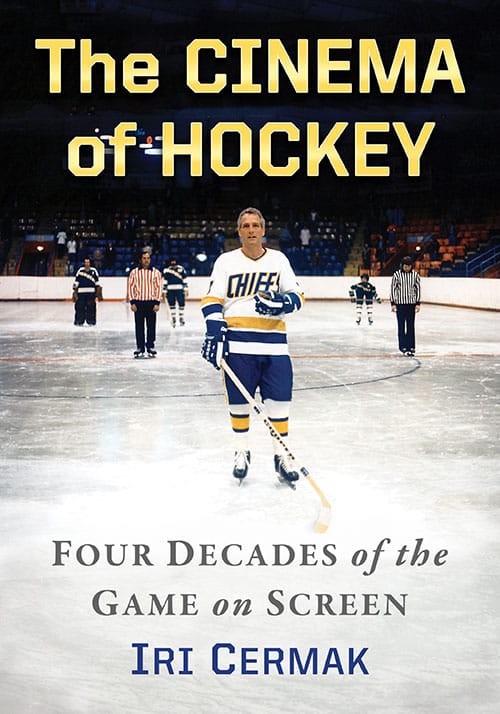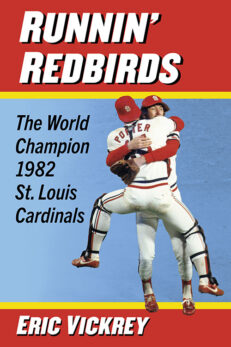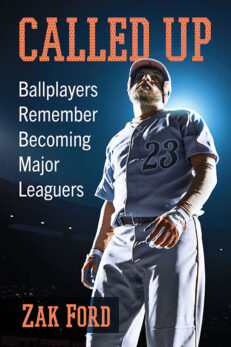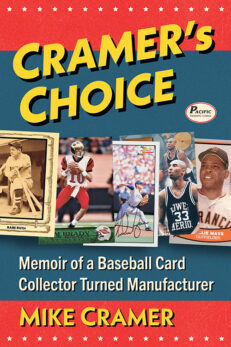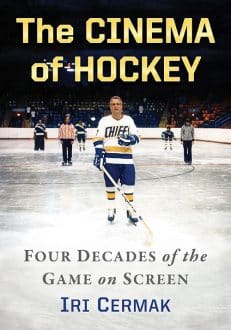Acknowledgments ix
Preface 1
Introduction 3
Why Study Hockey as a Repertoire? 5
Hockey, Masculinity Archetypes and North American Scripts of Nationhood 10
Cultural Archetypes and the Quandaries of Depicting Hockey in Film 16
Approaching the Hockey Lineup in This Book 21
1. Critiques of Hockey as Aggressive Muscularity 25
Bully Hockey in Canadian Film: Paperback Hero, The Last Season and Gross Misconduct 27
Bully Hockey in Hollywood Film: Ice Castles, Love Story, The Deadliest Season and Youngblood 39
2. Spoofs of Aggressive Muscularity: The Pleasures of Sporting Excess 48
The Bully-Clown in Hollywood Film: Slap Shot, Happy Gilmore, Tooth Fairy and Just Friends 49
The Bully-Clown in Canadian Film: Score: A Hockey Musical, Goon,
Keep Your Head Up, Kid: The Don Cherry Story and Wrath of Grapes:
The Don Cherry Story II 62
3. Critiques of the Business of Hockey 77
The System Against the Athlete: Face Off (Winter Comes Early) 77
Hockey in Crisis: Net Worth and Sudden Death 81
The Hockey Protagonist on the Frontier: Mystery, Alaska 90
The Disillusioned Protagonist: No Sleep ’til Madison and Slap Shot 2: Breaking the Ice 97
4. Hockey and Family Entertainment 104
Disney’s Vision of Hockey: The Mighty Ducks, D2: The Mighty Ducks, D3:
The Mighty Ducks, H-E-Double Hockey Sticks and Den Brother 106
Hockey in Canadian Family Fare: Ronnie and Julie, MVP: Most Valuable Primate, Slap Shot 3: The Junior League and Sticks and Stones 116
5. Hockey, Masculinity and Nationhood in Quebec Cinema 130
Quebec and the Montreal Canadians: The Mystery of the Million Dollar Hockey Puck and The Sweater 132
Les Boys I, II, III, IV: Hockey, Identity and Commercial Success 138
Il était une fois les Boys: Les Boys and the Family Genre 148
Quebec’s Hockey Icon and the Nation: Maurice Richard/The Rocket 153
Mending Canada’s Cultural Divide: Bon Cop, Bad Cop 159
6. Hockey Biopics and the Nation 167
The Memory Work of Allegiance: ABC’s Miracle on Ice and Disney’s Miracle 168
Negotiating the Nation: Canada Russia ’72 177
Coaching and Honing Character: The Hounds of Notre Dame,
Keep Your Head Up, Kid/Wrath of Grapes and Waking Up Wally:
The Walter Gretzky Story 185
7. Hockey, Race and Sexuality 199
Ethnicity and the Hockey Protagonist: The Love Guru and Breakaway/
The Speedy Singhs 199
Sexuality and the Hockey Protagonist: Perfectly Normal, Breakfast with Scot, Grown Up Movie Star and The Sheldon Kennedy Story 207
8. The Women’s Game 220
Forging a Path for Women in the Game? Hockey Night, Ice Angel, Go Figure, Chicks with Sticks, National Lampoon’s Pucked and Les Pee Wee 3D:
L’hiver qui a changé ma vie 221
9. The Hockey Spectacle in Film 239
The Grammar of Hockey in Film 239
Goal-Orientation 241
Toughness 246
The (Lesser) Role of Goaltending 248
The Dream and the Work Ethic 250
The Use of Archival Footage 251
Overview 254
Conclusion 258
Filmography 265
Chapter Notes 268
Bibliography 305
Index 323
Review Fix chats with The Cinema of Hockey: Four Decades of the Game on Screen author Iri Cermak, who breaks down the creative process behind the book and more.

Review Fix: How did this project begin for you?
Iri Cermak: The idea took form gradually. I wrote my PhD dissertation on US and Canadian Olympic TV hockey coverage, so I had a sense of what it takes to assess media products that have the moving image as fundamental component. As an offshoot, I also became interested in cinema. So, when Disney’s Miracle was about to hit theaters in March 2004 –and since I’d covered the 1980 U.S. victory in prior work– I was excited to see what producers had done with it. At the first matinee you could see three generations at the table. Seniors were avidly talking about it outside the theater. And a couple who struck me as school teachers came in with a dozen or so second graders, which means that it was seized on as a chance to teach about this pivotal event in U.S. sports history. As a Disney movie, it also had a built-in PG rating. The film did well at the box office too. It showed that the win indelibly marked the culture as a whole.
Review Fix: What was the writing process like?
Iri Cermak: At this point I wish I could say, “And the rest is history!” But that wasn’t the case — not by any stretch. Before I could write, I had to find what films were out there –what would be my sample— and it proved to be a Herculean task. The handful of “Best Hockey Movies” sites on the web at the time listed the usual suspects –films like Slap Shot, Youngblood, The Miracle on Ice, and The Mighty Ducks. And they were a good starting point, but none of these sites listed any Canadian films. So I went to old sport film anthologies, where I found brief mentions of one or other movie. To make a long story short, I gradually compiled a list of must-haves and immediately watched what was readily available, which were mostly Hollywood theatrical releases. Canadian-made films –movies like Face-Off (1971), Paperback Hero (1973),and The Last Season (1986)—were occasionally rebroadcast on the Canadian Broadcast Corporation (CBC), but were otherwise not in wide circulation.
Yet even a TV movie produced for the CBS network in the U.S., The Deadliest Season (1977), was tough to pin down. I found it rather fortuitously on a database of old films. The VHS copy had Portuguese subtitles! I certainly wondered about that backstory. I also ended up seeing a couple of films with special permission and sometimes within a very brief time window. Needless to say, I was grateful for any assistance offered.
There was another small detail to the story: When I first started out, at least half of the movies that would eventually end up in the book had not yet been produced.
I’d say it wasn’t until 2008 when more films started showing up and I was able to widen the scope of the work. A larger data set yields greater detail and I needed quite a bit of detail since I was dealing with three national cinemas: Hollywood, English-Canadian, and Quebec-made films. I would have liked to include more movies, but the project would have taken fifteen years instead of ten.
Review Fix: What’s the best hockey film no one knows about?
Cermak: Instead of recommending one film, I’d suggest branching out of family fare. The older movies –if you can find them– are foundational to anyone interested in the history of the sport. And because they are not biopics –remakes of past events sometimes decades later—there is a certain rawness in the way topics relevant to the period are aired. Part of it is the movie technology of the time, which undergirds the aesthetics. But these films also deal with issues that run throughout the collection and are still debated today, issues that could be subsumed under one question: Who does hockey belong to? In other words, how should the game be played?
Toughness in hockey early on linked to ideas of vigorous manhood and its usefulness to the nation at a time when masculinity itself was deemed to be in crisis. None other than President Teddy Roosevelt, in a 1907 address to Harvard Union, admonished students not to turn into “mollycoddles” and to play hockey and other “manly” sports to become the type of men the nation needed.
In the 1970s and 80s, the main preoccupation was violence. In the era of the “Big Bad” Boston Bruins and the Philadelphia Flyers, aka “Broad Street Bullies”, violence won games, and even Stanley Cups. Scenes like the one in Slap Shot, where police visit the locker room, were part and parcel of the professional game, which Nancy Dowd captured with such wit in the classic. Slap Shot’s contemporary, The Deadliest Season, for instance, concerns a fictional pro player-turned-goon (Michael Moriarty) who accidentally kills his best friend on another team. As a harbinger of what’s to come, Meryl Streep, who plays his wife, throws him out of bed one night for busting up a younger player’s lip. The courtroom scenes debate who’s at fault for engendering the kind of spectacle that leads to murder, and the defense fingers all parties: players, owners, sponsors, and fans!
The Last Season, based on the novel by Roy MacGregor and aired on the CBC, goes even further. The fictional player is former Flyer Felix Batterinski (Booth Savage), who transplants goon hockey to Finland when he’s hired as a coach to firm up the team’s play. His tactics implode, and he returns back home to Canada, where he ends up taking his life. Likewise, the Atom Egoyan-directed CBC-aired Gross Misconduct (1993), although produced later on, also gives a glimpse of the era’s hockey through the life and times of journeyman defenseman Brian Spencer (Brian Kash). This player also ends up dead at the end of the movie.
But even movies of the period, which are not hockey films proper, feature central male characters that relish the rough game, and in so doing, display their masculine credentials. For example, in Ice Castles (1978), which is marketed as a figure skating film, the male protagonist (Robby Benson), a pre-med student who is also the female lead’s love interest, prides himself in playing “suicidal hockey”, and none other than the training camp coach gives him a scolding as he demands why someone with his smarts would want to play a game where he will get his brains beat out. Even earlier, in Love Story (1970), Harvard law student Oliver Barrett IV (Ryan O’Neal) recklessly throws his weight around during matchups and repeatedly ends up in the penalty box. He dissuades his love interest (Ali MacGraw) from coming to see him play because things will get messy. You can certainly say he’s no “mollycoddle”.
Review Fix: What makes a great hockey flick?
Cermak: It’s one in which the story is tightly structured around an underdog’s unexpected rise and triumph, with all “the slings and arrows of outrageous fortune” thrown in. The reason is that “development from humble origins”, to quote narratologist Misia Landau, appears to be a core organizing feature of the human experience, and for this reason, is key to effective storytelling. In other words, the hockey stories that most resonate are highly mythical in nature. In the hockey collection, Miracle and Maurice Richard – based on larger-than-life people and events—take top billing in this respect. And, incidentally, it doesn’t follow that films based on archetypal characters and occurrences should necessarily reach mythic resonance. Execution is everything.
This brings me to a key feature of the sports genre: verisimilitude –or believability– as it relates to the actor’s performance on the field. If the athletic skills are too limited, they can make or break a sports movie. Some productions have solved this problem by inserting real hockey players as doubles in practice or in game sequences. Miracle’sproducerswent a step further. They hired hockey players who could act. And that decision was intrinsic to the movie’s success. It’s not surprising that this film also features an astonishing 20 minutes of game time that takes viewers on a rollercoaster ride. Of course, Kurt Russell’s stellar performance as coach Herb Brooks is pivotal – it absolutely makes the film, particularly given that Miracle focuses on Brooks’ story.
Much the same goes for Maurice Richard, a film of unrivalled beauty, carefully crafted, and well acted, with star Roy Dupuis in the lead. It is the most beautiful film in the entire collection, a sign of the respect that Richard –the first NHLer to score 50 goals in a season– still evokes in Canada and, in Quebec, in particular. It also goes without saying that in most Canadian films, actors can skate and play hockey. They deliver in the crucial matchup typically positioned at the end of the film. And what’s a sports movie without a final, the space where the myth takes material form!So, it’s a real bonus for any production to boast actors that can do both well.
Still, biopics with a great deal of mythical resonance tend to flatten out historical detail. And there are times when myth could withstand a dose of reality, which brings me to an earlier version of the 1980 US win –the ABC 4-hour TV miniseries Miracle on Ice (1981). This movie aired relatively soon after the event. For this reason, it’s more historically accurate than the Disney feature. It’s also why, in the book, I look at both films side by side and intersperse quite a bit of media coverage to give readers a better idea of circumstances surrounding the victory. Films with mythical resonance are intensely emotional. They sweep you off your feet and carry you along, which is part of the enjoyment of watching them. But you have to dig deeper with these kinds of movies to get closer to what really went on.
Now with Canada Russia ’72 –a four-hour CBC miniseries that portrays the first-time meeting between Canadian NHLers and the Soviet national team in September of 1972 —there is a twist. The contest, now known as the Summit Series, which aired live on the CBC both in English Canada and Quebec, is still remembered as the seminal event in Canadian hockey history. So, it too is of great mythical import. But English-Canadian films, which are teeming with antiheroic types and realist features, tend to bring protagonists down a notch. And the miniseries doesn’t treat the NHLers who participated, or even their coaches, with kid gloves. I also had the chance to watch over half a dozen documentaries about the contest for an essay in Brian Kennedy’s edited book, Coming Down the Mountain: Rethinking the 1972 Summit Series. The docs feature interviews of players on both teams and are interspersed with actual game footage. And you literally hear and see the intensity. Together miniseries and documentaries also give a good sense of the media as third player in the event. And because the series comprised eight games, it allowed for a very complex situation to develop. So, it really pays to look into it.
Review Fix: What’s your favorite hockey film and why?
Cermak: All CBC-produced and/or aired films in the book are striking. The CBC folks have been at it for decades, including coverage of NHL games through Hockey Night in Canada broadcasts, which has now gone to another network. But they know what makes a good hockey story and how to deliver it. So, yes, you can’t beat a CBC movie.
Goon (2011) is also a favorite because of the ingenuity in shaping a main protagonist (Seann William Scott) as sweet and sensitive with women, loyal to a fault vis-à-vis teammates, and with the heart of a lion out on the ice. Among Quebec films, aside from Maurice Richard, Bon Cop, Bad Cop (2006) is a mustfor the comical way it takes viewers on a tour of the Anglophone-Francophone divide in Canadian culture. Again, it airs the question of who gets to stake a claim on the game, as two cops –one from Quebec (Patrick Huard) and the other from Ontario (Colin Feore)– try to upstage each other in the process of solving several hockey murders.
All films that I look at in the book have a charm point, really. I only wish that the ones that are hard to see could be released in streaming formats to make them more easily accessible to larger audiences.
Review Fix: What’s an overrated hockey flick?
Cermak: That’s an interesting question given that sport films until rather recently had virtually no proponents who deemed them a distinct genre. Hollywood producers themselves have been quite cautious about marketing films in a similar vein because no sport film has ever been in contention for an Oscar. If anything, then, hockey movies are underrated –certainly as a collection. And, in this respect, every film is valuable as a piece of the puzzle.
Review Fix: What did you learn about hockey that you didn’t expect from this?
Cermak: I learned that these movies actually track the history of the sport pretty closely. Although I didn’t organize the book to conform to historical eras but to themes, you can actually make out the time periods by checking the year of release. If you’re interested in hockey, its history, the business aspect, etc. — and how these mesh with domestic politics, the geopolitical context, socio-culturally important developments such as changing gender roles, to name a few — it’s all there in the movies.
Review Fix: Why do you think it’s important today?
Cermak: Media products, particularly aired or re-aired on TV, tend to be ephemeral by their very nature due to a characteristic “presentism”, to reference Gary Edgerton’s work. In other words, they are pervaded with the urgency of the now, which makes for easily forgetting the historical conditions under which events occurred and the meanings ascribed to them. Books like this one –along with the films it ‘recovers’– are meant in part to serve as a reference guide. Of course, as noted earlier, I organized these movies in a particular way, which may or may not be what other authors would’ve chosen. Still, the very act of compiling these films in one place, to my mind, was essential. It shows that there are other ways of looking at hockey-related events and the people behind them. But context is always key. You cannot obliterate the original context, which is also why there are ample Notes and Bibliography sections in the back of the book to provide additional detail.
Review Fix: How do you want the book to be remembered?
Cermak: As a step forward in the study of the game… This work was logistically difficult to undertake. And it unequivocally owes itself to the research of countless North American and European hockey scholars, and depends on decades of feature film and documentary production. And, of course, it was inspired by those who played the game, coached it, managed it, and brought it to people’s living rooms. It was also made possible by those who have taken the time to carefully collect the necessary raw materials and sources to carry it out. So it’s a kind of homage to so much in hockey that went before it.
Review Fix: What’s next?
Cermak: I am now doing analysis of wildlife films, although I’m not giving up on hockey research entirely. One can also apply narrative techniques in hockey films to the portrayal of endangered animals – especially the large charismatic species. A number of them are chiefly represented in the category of ‘top dog’. But they’re truly underdogs because their numbers are seriously on the wane. And their habitats –ecosystems which we also depend on– are in deep trouble for this very reason. How do you manage this contradictory imagery? I’ve seen hockey films and documentaries in which producers had to do both for the narrative to work. So, you can always find connections across genres.

